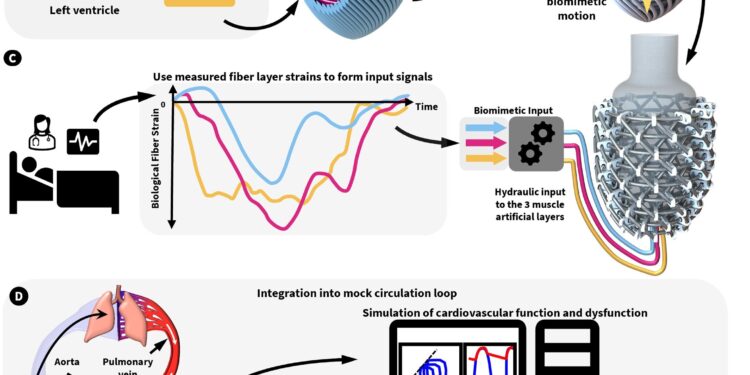Credit: Thanh Nho Do
A team of biomechanical engineers from the University of New South Wales, working with a colleague from the Queensland University of Technology and cardiac surgeons from St Vincent’s Hospital in Sydney, have developed a left ventricle (LV) of artificial human heart that can be used to train the heart. surgeons and other doctors.
In their article published in the journal Scientific roboticsthe group describes how the artificial LV was made, its characteristics and possible uses.
Because the LV can be animated, the researchers describe it as a type of robot capable of imitating the movements of a real human heart. It is also adjustable, meaning it can be configured to mimic the heart of a patient about to undergo heart surgery, allowing a surgeon to perform a procedure before heading to the operating room.
To create the LV, the researchers set out to create a device that could simulate all types of movements that occur in a real heart, including those involving radial movement. To create such a device, they attempted to replicate the three basic muscle types of the human heart.
The LV they created has three layers intended to mimic the epicardium, transmural, and endocardium, all made using “artificial tunable hydraulic filament muscle fibers.” This allowed them to customize the density of the heart muscle, the angles of the fibers that connect the muscles together, and its ventricular shape. The LV is also capable of pumping simulated blood.
Testing of the device was carried out by connecting it to pipes that carry the artificial blood in a loop. Surgeons at St. Vincent Hospital tested compatibility with real human hearts, evaluating the device when it was held still and while it beat, pushing blood through the pipes. In doing so, they found the LV capable of faithfully simulating the actions of a real human heart.
The team also tested the device’s ability to be configured to mimic heart conditions requiring medical intervention and respond in the same way that the human heart would as repaired by a surgeon, including by equipping the LV with an intra-aortic balloon pump as it was. beat.
The team concludes by saying that their device is a much better training aid than other artificial hearts currently available and expects it to become a tool used by clinicians, instructors and students learning to treat heart disease.
More information:
James Davies et al, Soft robotic artificial left ventricle simulator capable of reproducing the biomechanics of the myocardium, Scientific robotics (2024). DOI: 10.1126/scirobotics.ado4553
© 2024 Science X Network
Quote: Artificial left ventricle mimics the shape and function of the human heart (October 2, 2024) retrieved October 2, 2024 from
This document is subject to copyright. Except for fair use for private study or research purposes, no part may be reproduced without written permission. The content is provided for informational purposes only.



